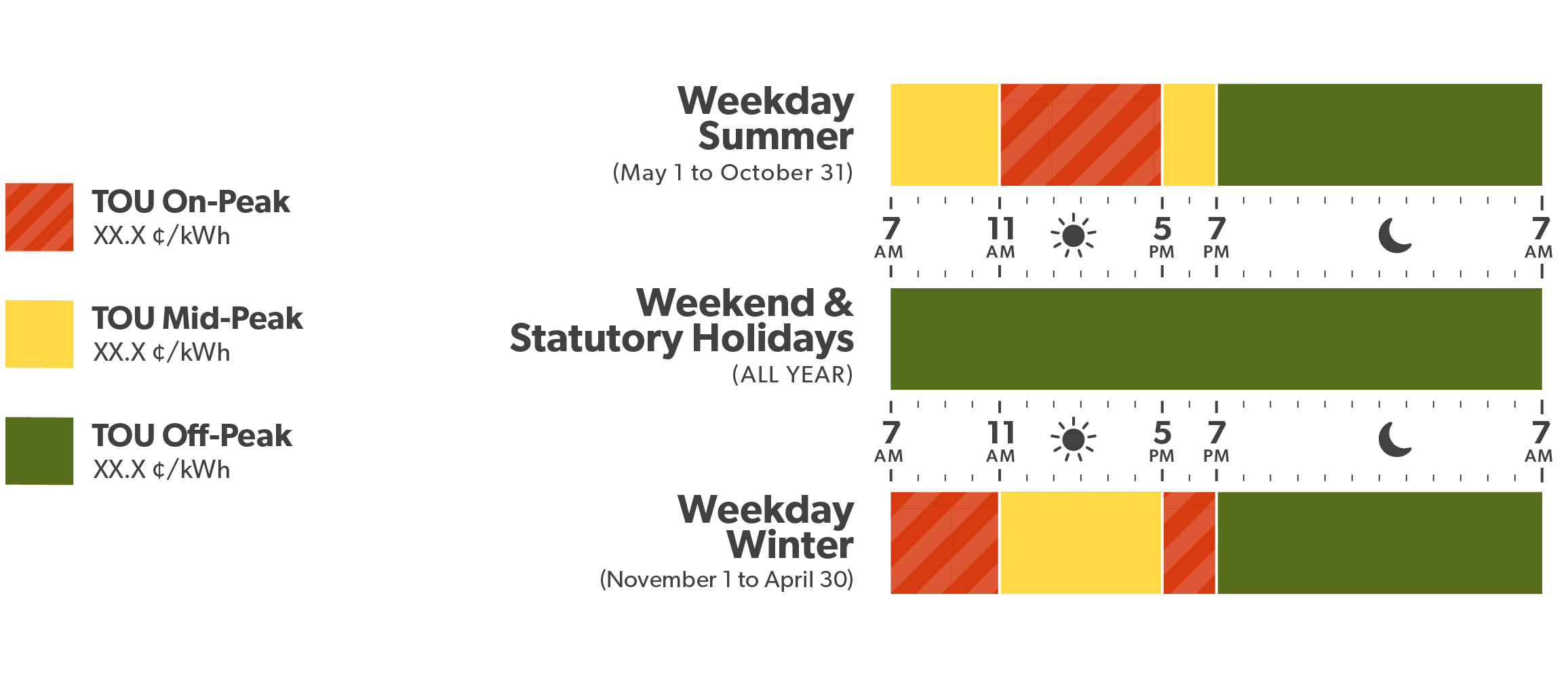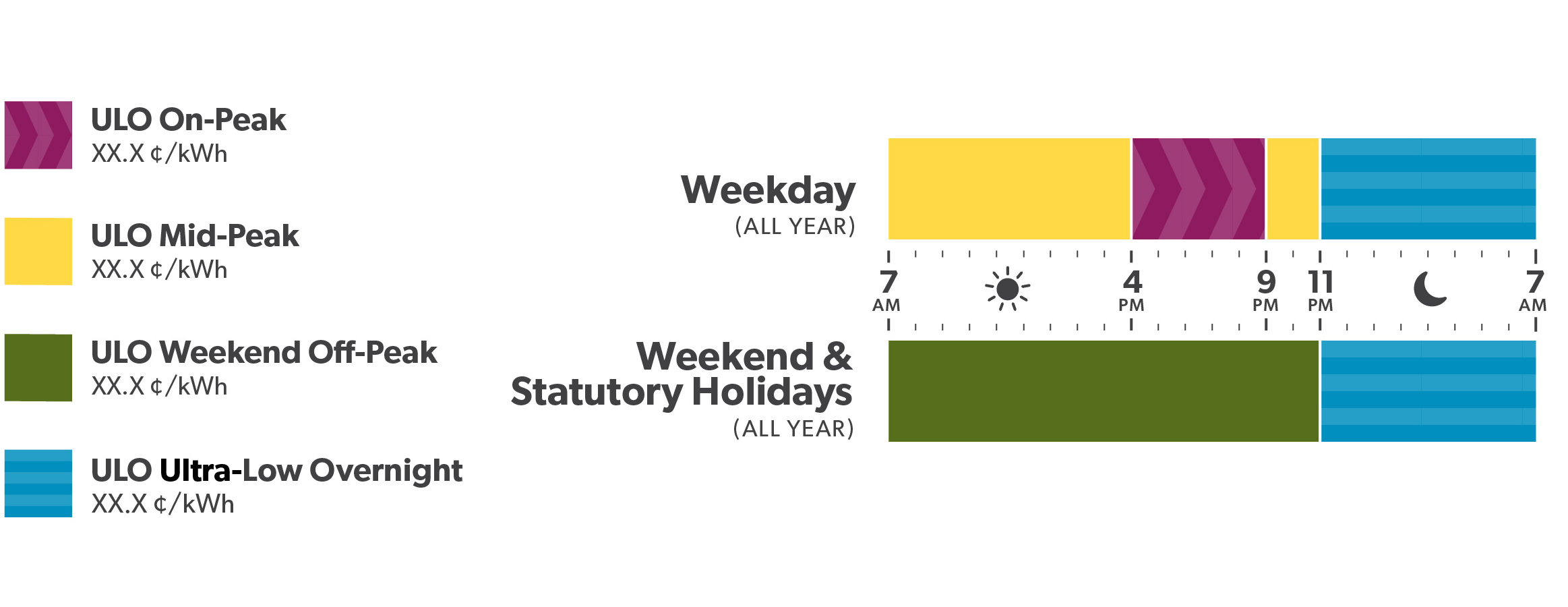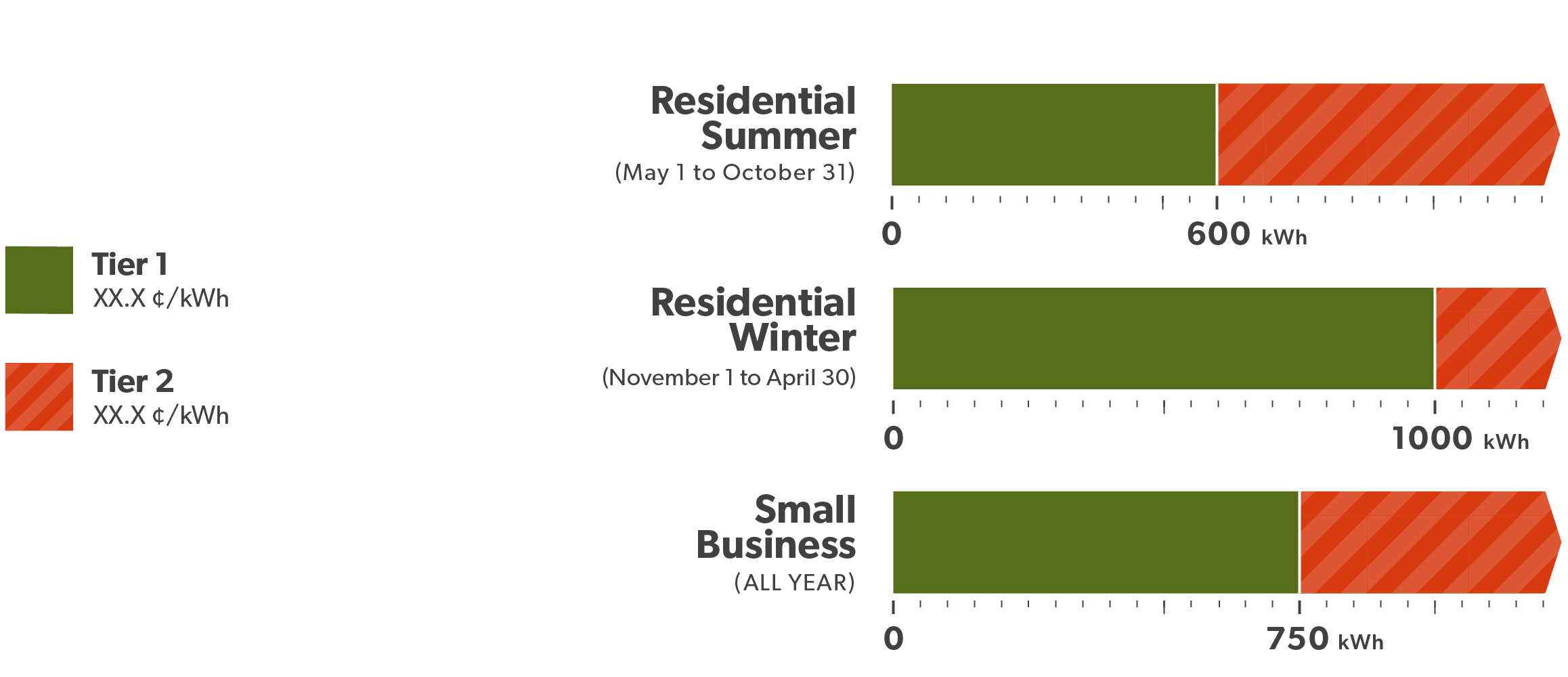As part of our mandate, we set the rates that your utility charges for the electricity you use in your home or small business. These rates appear on the Electricity line of your bill. We also set the Delivery rates that cover the cost to deliver electricity to most residential and small business customers.
Types of electricity rates
For residential and small business customers that buy electricity from their utility, there are three different types of rates (also called prices here). The Ontario Energy Board sets rates once a year on November 1.
With TOU and ULO, the price depends on when you use electricity. This means you can help manage your electricity costs by shifting your usage to lower price periods when possible.
With Tiered, the price depends on how much electricity you use overall in a month.
Time-of-Use (TOU)
There are three TOU price periods:
- Off-peak, when demand for electricity is generally lower. Ontario households use most of their electricity – nearly two thirds of it – during off-peak hours.
- Mid-peak, when demand for electricity is moderate. These periods are during the daytime, but not the busiest times of day.
- On-peak, when demand for electricity is generally higher. These are the busier times of day – generally when people are cooking, starting up their personal electronics and running heaters or air conditioners.
TOU price periods are different in the summer (May 1 – October 31) than they are in the winter (November 1 – April 30). No matter which season, on weekends and holidays the cheapest rates are in effect all day. View the Holiday Schedule for Time-of-Use and Ultra-Low Overnight.

Ultra-Low Overnight (ULO)
There are four ULO price periods:
- Ultra-Low Overnight, when demand for electricity is lowest on average.
- Weekend Off-peak, when demand for electricity is generally lower.
- Mid-peak, when demand for electricity is moderate.
- On-peak, when demand for electricity is highest on average.
The ULO price periods are the same in the summer as they are in the winter. On weekends and holidays the cheapest rates are in effect all day. View the Holiday Schedule for Time-of-Use and Ultra-Low Overnight.

Tiered
With Tiered prices, you can use a certain amount of electricity each month at a lower price. Once that limit (called a threshold) is exceeded, a higher price applies. The threshold changes with the season to reflect changing usage patterns – for example, there are fewer hours of daylight in the winter and some customers use electric heating.
In the winter period (November 1 – April 30), the Tier threshold for residential customers is 1,000 kWh, so that during the heating season households can use more power at the lower price. In the summer period (May 1 – October 31), the Tier threshold for residential customers is 600 kWh. The Tier threshold for small business customers is 750 kWh all year round.
Tiered prices give you the flexibility to use electricity at any time of day at the same price, although that price will change if you exceed the threshold during the month.

If you’re a residential or small business customer, you can choose to switch between Time-of-Use (TOU), Ultra-Low Overnight (ULO) and Tiered prices. Read more about choosing your electricity price plan.
For customers that have signed up for a contract with an energy retailer, the price is set out in the contract. The Ontario Energy Board does not regulate this. Read more about contracts.
Current prices
The TOU, ULO and Tiered prices set by the OEB for November 1, 2025, are shown in the table below. View historical electricity prices.
Time-of-Use (TOU)
| TOU Price Periods | Winter (November 1 - April 30) | Summer (May 1 - October 31) | TOU Prices (¢/kWh) |
|---|---|---|---|
| Off-Peak | Weekdays 7 p.m. – 7 a.m. Weekends and holidays all day | Weekdays 7 p.m. – 7 a.m. Weekends and holidays all day | 9.8 |
| Mid-Peak | Weekdays 11 a.m. – 5 p.m. | Weekdays 7 a.m. – 11 a.m. and 5 p.m. – 7 p.m. | 15.7 |
| On-Peak | Weekdays 7 a.m. – 11 a.m. and 5 p.m. – 7 p.m. | Weekdays 11 a.m. – 5 p.m. | 20.3 |
Ultra-Low Overnight (ULO)
| ULO Price Periods | All Year | ULO Prices (¢/kWh) |
|---|---|---|
| Ultra-Low Overnight | Every day 11 p.m. - 7 a.m. | 3.9 |
| Weekend Off-Peak | Weekends and holidays 7 a.m. – 11 p.m. | 9.8 |
| Mid-Peak | Weekdays 7 a.m. – 4 p.m. and 9 p.m. to 11 p.m. | 15.7 |
| On-Peak | Weekdays 4 p.m. – 9 p.m. | 39.1 |
Tiered
| Tier Thresholds | Winter (November 1 - April 30) | Summer (May 1 - October 31) | Tiered Prices (¢/kWh) |
|---|---|---|---|
| Tier 1 | Residential – first 1,000 kWh/month Non-residential – first 750 kWh/month | Residential – first 600 kWh/month Non-residential – first 750 kWh/month | 12.0 |
| Tier 2 | Residential – for electricity used above 1,000 kWh/month Non-residential – for electricity used above 750 kWh/month | Residential – for electricity used above 600 kWh/month Non-residential – for electricity used above 750 kWh/month | 14.2 |
Electricity prices in energy contracts
Fewer than 1 in 10 customers in Ontario buy their electricity from an electricity retailer. If you’re thinking about signing an energy contract, you will pay the price in the contract, which is not regulated by the Ontario Energy Board. Learn more about energy contracts.
The Global Adjustment
Most electricity generating companies get a guaranteed price for the electricity that they produce. The Global Adjustment is the difference between that guaranteed price and the money the generators earn in the wholesale marketplace. The Global Adjustment also covers the costs of some conservation programs.
All electricity consumers have to pay a share of the Global Adjustment. The Time-of-Use, Ultra-Low Overnight and Tiered prices charged by your electricity utility already include an estimate of the Global Adjustment. If you sign up for a contract with an energy retailer, you have to pay your share of the Global Adjustment on top of the contract price. The Global Adjustment will also appear as a separate line on your bill.
Visit the Independent Electricity System Operator (IESO) website for more information on the Global Adjustment.
Calculate your electricity bill
Electricity distribution utilities deliver electricity to your home or business and also issue your bill, unless you are a customer of a unit sub-metering provider. Use our calculator to estimate your monthly bill. You can also compare your current bill with what to expect if you sign a contract with an electricity retailer.
